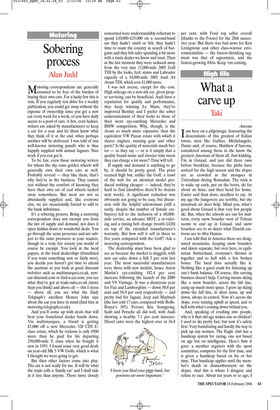Sobering process
Alan Judd
Motoring correspondents are generally assumed to be free of the burden of buying their own cars. For a lucky few this is true. If you regularly test drive for a weekly publication, you could get away without the expense of ownership since you get a new car every week for a week, or you have daily access to a pool of cars. A few, even luckier, writers are asked by manufacturers to keep a car for a year and let them know what they think of it at the end, when perhaps another will be delivered. I was told of one well-known motoring pundit who is thus happily supplied with annual Jaguars. Nice work if you can get it.
To be fair, even those motoring writers for whom the sky rains golden wheels will generally own their own cars as well. Probably several — they like them, that’s why they’re in the business. They cannot rest without the comfort of knowing they have their own set of real wheels tucked away somewhere. But most are not so abundantly supplied and, like everyone else, we are occasionally forced to add to the bank imbalance.
It’s a sobering process. Being a motoring correspondent does not exempt you from the law of supply and demand, nor does it open hidden doors to wonderful deals. You go through the same processes and are subject to the same pressures as your readers, though in a truly fair society you would of course be exempt. You look at the local papers, at the local dealerships (franchised if you want something new or fairly new), you decide you haven’t got time to attend the auctions so you look at good discount websites such as multimarques.co.uk, newcar-discount.com or find-a-car.com, you see what they’ve got at trade-sales.co.uk (more than you think) and above all — this I stress — above all, you see what the Daily Telegraph’s excellent Honest John says about the car you have in mind (find him at motoring.telegraph.co.uk).
And you’ll come up with deals that will beat your franchised dealer hands down. Via multimarques, a friend is getting £5,000 off a new Mercedes 320 CDI Eclass estate, which he reckons is only £900 more than he paid for his departing 250,000-mile E class when he bought it new in 1993. I found some very good deals on year-old Mk 5 VW Golfs, which is what I thought we were going to get.
But then other factors come into play. The car is not really for me. It will be what the trade calls a ‘family car’ and I shall ride in it less than anyone. Those more closely concerned were understandably reluctant to spend £10,000–£15,000 on a second-hand car they hadn’t smelt or felt, they hadn’t time to roam the country in search of bargains and they felt safer spending a bit more with a main dealer we know and trust. Then at the last moment they were seduced away from the very nice 11,000-mile 2005 Golf TDI by the looks, feel, status and Labrador capacity of a 54,000-mile 2003 Audi A4 Avant TDI, which cost £1,000 more.
I was not averse, except for the cost. High mileage on a new-ish car, given proper servicing, can be beneficial. Audi have a reputation for quality and performance, they keep winning Le Mans, they’ve improved Bentley and I prefer the sober understatement of their looks to those of their more eye-catching Mercedes and BMW competition. Why, though, is the Avant so much more expensive than the equivalent VW Passat estate with which it shares engines, running gear and other parts? Is the quality of materials much better — as they say — or is it simply that a quality brand name and classier trim mean they can charge a lot more? Time will tell.
If supply and demand is anything to go by, it should be pretty good. The price seemed high but, unlike the Golf, a trawl of the web for an identical model produced nothing cheaper — indeed, they’re hard to find (doubtless there’ll be dozens next week). A significant reduction was obviously not going to be easy, but discussion with the helpful saleswoman (still a rarity, despite the number of female carbuyers) led to the inclusion of a 60,000mile service, an advance MOT, a re-valeting and a timing belt change (worth £420) on top of the extended manufacturer’s warranty. But how will it sell in three to five years compared with the Golf? Ask a motoring correspondent.
The dealership must have been glad to see us because the market is sluggish, with new car sales down a full 5 per cent last year. The most successful manufacturers were those with new models, hence Aston Martin’s eye-catching 182.4 per cent increase following the launch of the DB9 and V8 Vantage. It was a disastrous year for Fiat and Lamborghini — down 50.8 per cent and 56.9 per cent respectively — and pretty bad for Jaguar, Jeep and Maybach (the last sold 17 cars, compared with RollsRoyce’s 105). Ferrari, Kia, Ssangyong, Saab and Porsche all did well, with Audi showing a healthy 7.1 per cent increase. Diesel sales were the highest ever at 36.8 per cent, with Ford top seller overall (thanks to the Focus) for the 28th successive year. But there was bad news for Ken Livingstone and other class-warrior environmentalists — the fastest-shrinking segment was that of superminis, and the fastest-growing 4X4s. Keep ’em coming.


















































































 Previous page
Previous page